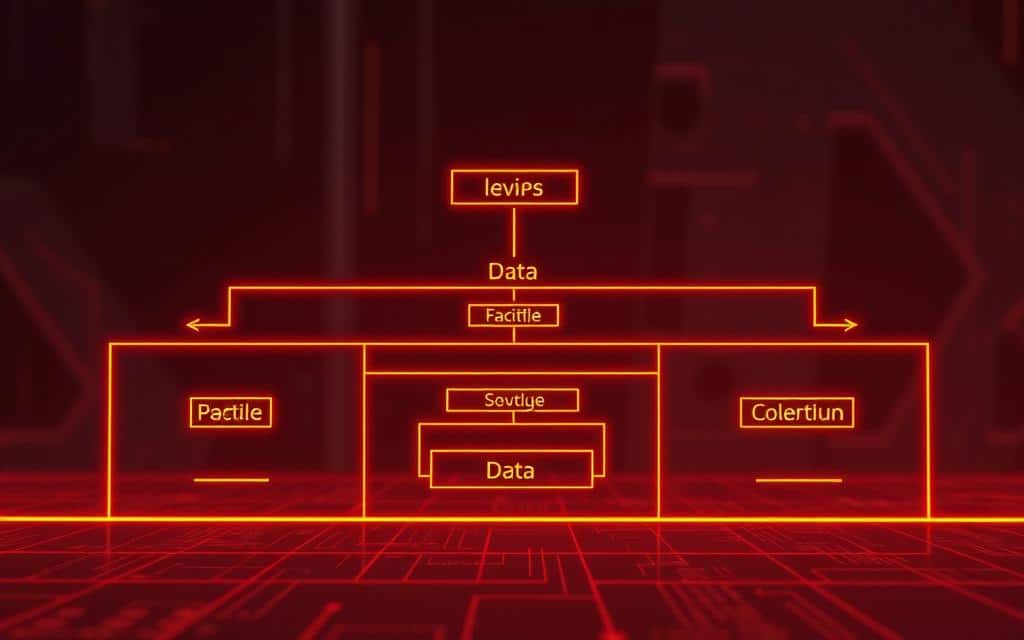Can a simple tree shape help your business tame messy data and speed up decisions?
This introduction gives you a plain-English tour of a classic model that links records with clear parent-child paths. You’ll see how a root-based structure makes navigation predictable and governance easier across your organization.
We’ll highlight real applications—from file catalogs and org charts to XML files and the Windows Registry—so you can map familiar systems to modern needs. Expect a focus on practical benefits like simplicity, built-in integrity, and fast, predictable retrieval.
Alongside those strengths, you’ll preview trade-offs such as rigidity and limited cross-branch queries. That helps you judge when this approach fits your information management goals and when other data models may serve you better.
What Is a Hierarchical Database? The Ultimate Guide Foundation
Ever wondered how a tree-like layout can make complex records easy to find? This section explains the core idea in plain terms so you can judge fit for your team.
At its heart, a hierarchical database organizes data as records in a tree structure. One top item—the root node—sits above branches of nodes. Each child record links to exactly one parent node, creating clear one-to-many relationships.
You navigate by following a path from the root node down a branch until you reach the target record. That defined route reduces ambiguity and makes access predictable for users and systems.
- Root node: the top of the tree.
- Parent node: a node that has children.
- Child nodes: descendants that belong to a single parent.
Under the hood, systems often use pointers or indexes to jump between related records. Storing parent and child records close together on disk speeds retrieval and keeps operations efficient.
| Feature | What it means | Why it helps |
|---|---|---|
| One root | Single entry point | Predictable paths for queries |
| One parent rule | Each child has one owner | Simpler integrity and fewer conflicts |
| Pointers/indexes | Physical links on disk | Faster, reliable access |
How the Hierarchical Model Works in Practice
What makes a single-root tree such a reliable way to store and fetch records? You get a clear anchor point — the root node — that every other node traces back to. That single origin simplifies where each record lives and how you find it.
The parent-child paradigm is strict: each child node links to one parent. This creates natural one-to-many relationships that are easy to reason about. When you design for one parent, conflicts drop and data integrity improves.

Data retrieval follows a deterministic path from the root through intermediate nodes to the target record. Knowing the path ahead lets systems optimize traversal with pointers or indexes, speeding access in large sets of data.
That predictability also helps auditing—when something changes, you can quickly find the upstream parent and affected children. The trade-off is limited cross-branch relationships; you may need duplication or external links for cross-cutting connections.
Quick comparison
| Concept | Behavior | Benefit |
|---|---|---|
| Root node | Single anchor for all nodes | Predictable navigation |
| Parent rule | Each child has one parent | Fewer conflicts, simpler integrity |
| Retrieval paths | Follow defined branches | Fast, reliable data retrieval |
Benefits That Keep Hierarchical Databases Relevant
Could a clear, top-down layout cut support tickets and speed up audits for your team? The answer is yes for many use cases. When your data maps to real-world categories, the structure is easy to teach and fast to validate.
Simplicity and predictability for data management
Simplicity reduces onboarding time and modeling errors. Teams see the path to each record, so day-to-day management stays steady and predictable.
Built-in data integrity and security by defined access paths
The one-parent rule enforces data integrity. Defined routes also let you scope permissions by branch, making audits and access control clearer.
Efficient, reliable retrieval at scale
Top-down navigation favors fast reads. Systems can cache or index along known routes to speed queries for high-volume, read-heavy applications.
- Fewer unknown joins — fewer edge cases to troubleshoot.
- Clear lineage — every change traces to a parent.
- Compartmentalized security — permissions follow the structure.
| Benefit | Why it helps | When to use |
|---|---|---|
| Predictability | Faster onboarding, fewer errors | Stable, category-driven applications |
| Integrity | Clear ownership and traceability | Systems requiring strict audit trails |
| Performance | Efficient reads via cached routes | High-volume, read-centric workloads |
Limits and Trade-offs You Should Consider
What happens when records need to relate in more than one way? The answer matters before you commit to a tree-like approach.
Many-to-many relationships force choices: duplicate entries, add cross-links, or build external tables. Each choice raises maintenance and consistency costs.
Reorganization challenges and rigid structures
Changing the structure after deployment can ripple through apps and reports that expect fixed paths.
Renaming or moving a node often needs code updates, migrations, and careful versioning.
Query limitations across non-hierarchical data
Cross-branch queries are awkward — you must climb and descend the tree to join sideways relationships.
Analysts who need cross-cutting views may see slower data retrieval and more complex queries.
- Do you need to model complex relationships across branches? Duplication or workarounds add maintenance.
- Placeholder parents solve temporary gaps but can clutter the structure if left unmanaged.
- Expect schema and application updates to be more involved than in flexible types of systems.
| Trade-off | Impact | Mitigation |
|---|---|---|
| Many-to-many records | Redundant records, inconsistency | Use cross-reference tables or hybrid approaches |
| Rigid structure | Complex reorganizations | Plan governance and versioning early |
| Cross-branch queries | Slower data retrieval | Precompute views or use complementary indexes |
Bottom line: you gain clear top-down retrieval and ownership, but you pay for it with rigidity when requirements evolve. Assess your access patterns and relationships data before choosing this approach.
Hierarchical Database Model Examples
You probably use several systems that store information in clear root-to-leaf paths.
Here are practical examples that show how this structure helps you manage data and access records fast.
File systems: directories and subdirectories
File systems like NTFS and HFS+ keep one root folder with nested folders and files. That makes navigation predictable and backups simpler.
Organizational charts and taxonomies
Org charts mirror parent and child roles—executives, managers, teams—so reporting lines are clear.
Biological taxonomy moves from kingdom down to species along a single path, which aids classification and searches.
Configuration, documents, and enterprise systems
The Windows Registry stores keys and subkeys for scoped configuration changes. XML files use nested elements so parsers validate structure easily.
Large transaction systems such as IBM IMS power banking and telecom workloads by using this proven approach for fast, reliable access.
Manufacturing, healthcare, and web navigation
Bills of Materials break finished goods into components and subcomponents, improving parts tracking.
Healthcare records roll up from hospital to department to patient, helping audits and controlled access.
Website sitemaps map home to categories and subpages—both users and crawlers follow the same structure.
- Why it helps: clear ownership, simple traversal, and scoped changes.
- Common applications and systems benefit when records follow a single parent path.
- For practical guidance, see our database best practices.
| Example | Systems | Why it fits | Typical use |
|---|---|---|---|
| File systems (NTFS, HFS+) | OS storage | Predictable paths, easy backups | Desktop and server storage |
| Windows Registry / XML | Config & documents | Scoped changes, deterministic lookup | App settings, structured data |
| IBM IMS / BOM | Enterprise systems | High throughput, clear parts hierarchy | Banking, telecom, manufacturing |
| Org charts / Taxonomy / Sitemaps | Business & web | Clear reporting and navigation | HR, classification, SEO |
When to Use Hierarchical Data vs. Other Models
Which data patterns justify a strict top-down layout, and when should you pick something else?

Choose a hierarchical model when your records form clear parent-child relationships and access follows predictable routes—think catalogs, org charts, or sitemaps. That setup favors fast reads and straightforward lineage for audits.
When relational databases or network types fit better
Use relational databases if you need flexible joins, ad hoc queries, and normalized tables across broad domains. They excel for analytics and complex queries that span many tables.
Consider network-style models when entities legitimately have multiple parents and you want to avoid duplication. These types handle complex relationships more naturally than a strict tree.
- Read-heavy, predictable traversal → hierarchical model.
- Ad hoc queries, many joins → relational databases.
- Multiple parent links, web-like connections → network models.
| Use case | Best fit | Why it fits |
|---|---|---|
| Catalogs, sitemaps | Hierarchical model | Predictable paths, simple lineage |
| Ad hoc analytics | Relational databases | Flexible joins, faster insights |
| Many-to-many entities | Network models | Multiple parents without duplication |
Rule of thumb: if your data looks and stays like a tree, keep the tree. If it behaves like a web, pick a model that maps that complexity to your business needs.
Design and Implementation Considerations
Good design prevents costly rewrites—plan your tree before users rely on it.
Start by documenting how records will relate to each other. Clear rules cut surprises later and keep data integrity visible to teams.
Pointers, indexes, and physical layout
Use pointers or indexes to link a parent to each child. That speeds lookups and keeps traversal predictable under load.
Store related records near each other on disk so data retrieval follows short, cache-friendly paths from the root through nodes.
Planning for change and governance
Because reorganizations are costly, design for change up front.
- Document the one parent constraint so designers know when to add references or duplicates.
- Version schemas, test moves in staging, and script migrations to avoid downtime.
- Mirror permissions to branches—security often follows the same structure.
| Risk | Mitigation | Operational step |
|---|---|---|
| Cross-branch queries | Denormalize or replicate | Precompute views for analytics |
| Node corruption | Integrity checks | Runbooks for recovery and consistency |
| Unexpected schema change | Governance and versioning | Test reorganizations in lower environments |
Monitor read patterns—if many queries jump across branches, plan denormalized views or an analytical copy. For indexing strategy details, see our guide on how indexing works.
Key Takeaways for Applying Hierarchical Models Today
Can keeping each record tied to one parent cut complexity and speed operations? Yes—when your information is naturally tree-like, a hierarchical database gives clear paths, a known root, and simple integrity checks.
Keep the one parent rule central. It makes navigation predictable and improves data integrity as you move from a parent node to child nodes.
Favor this approach for stable systems and read-heavy workloads—file systems, XML stores, the Windows Registry, and IBM IMS are proven examples that show why it works.
Plan for relationships that span branches. Combine models: keep the tree for transactional work, and replicate to other databases for analytics and cross-branch queries.
The bottom line: choose the system that mirrors how your data must flow, design for change, and use complementary models where flexibility is essential.